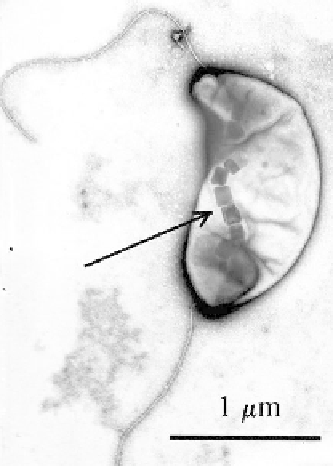Environmental Engineering Reference
In-Depth Information
FIGURE 18.2 A
bacterium containing magnetosomes; arrow points to magnetosomes
(image courtesy of Richard Blakemore).
Negative phototaxis can serve as a form of geotaxis. This active move-
ment is a strategy used by some protozoa that prefer anoxic habitats
(Doughty, 1991). It allows them to avoid areas where photosynthetic or-
ganisms are producing O
2
.
Chemotaxis is the movement toward or away from chemicals. Mi-
croorganisms are generally small enough that they cannot sense a chemi-
cal gradient across the cell (molecular diffusion is rapid enough over sev-
eral micrometers to disallow such steep gradients to be maintained). Only
the largest multicellular microbes may be able to sense differences from one
side of the organism to the other. However, the ability to find and exploit
chemical patches offers a selective advantage even to pelagic bacteria
(Blackburn and Fenchel, 1999), so the ability to integrate information on
chemical concentrations across time is important to some bacteria. Several
search strategies can be used to move into regions where the desirable sig-
nal originates. Microbes most commonly use the random walk strategy
(Fig. 18.3). An example of this is the swim and tumble strategy used by
Escherichia coli
in which the bacterium swims for a short time and then
stops and tumbles rapidly. If better conditions are encountered (e.g., higher
sugar concentrations), longer runs are taken; with worse conditions, shorter
runs are taken. This searching mode allows the bacterium to move toward
a chemical signal. The search strategy is not limited to microorganisms;
salmon trying to find their home streams exhibit similar behavior (Hasler
and Scholz, 1983).
The hot spring-inhabiting cyanobacterium,
Oscillatoria terebriformis,
exhibits several behaviors to increase its survival through adaptive move-
ments (Richardson and Castenholz, 1987a,b). The community setting of
this organism was discussed in Chapter 15. This cyanobacterium is posi-


Search WWH ::

Custom Search